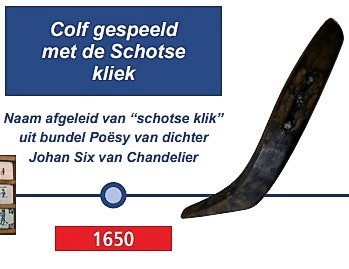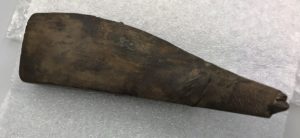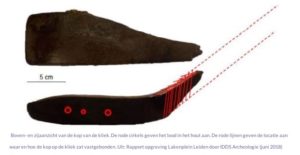1650: Colf played with the Scottish clique
In addition to colf sticks with a lead slipper, in the 17th century colf sticks were also used with colf sticks of which the striking piece was made of wood and was weighted internally or externally with lead.
This Scottish clique distinguished itself from the Leiden clique at the time in that the Scots made the wooden striker heavier internally with three circular lead patterns. Where the Leiden cob makers – united in 1660 in the Kolfmakersgilde – finished the flask by casting it with lead and applying the stamp of the city to the lead.
The Scottish clique got its name from the poem ‘s Amsterdammers Winter from the collection Poësy by Johan Six van Chandelier from 1657, who calls it ‘Scottish click’. Possibly because of the sound the stick made when hitting the ball.
The poem ‘s Amsterdammers Winter describes in short and simple rhyme how a colver straps on his skates or his stirrups before playing and, after the games have been drawn, tees off with his ash lead Dutch colf or his Scottish click of palm wood, and gives the leather ball filled with feathers a distant blow from a heap of snow, which is followed by ball-markers. The ball is hit with a long stroke to a pole in the ice as a target and for the fewest strokes. The strokes are recorded on a notch stick, which the colver keeps in the front of his wool coat. The poem concludes with the warning that incorrectly noting the number of strokes leads to total exclusion.




